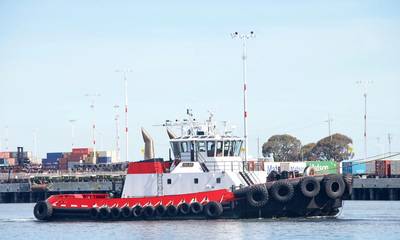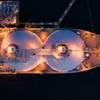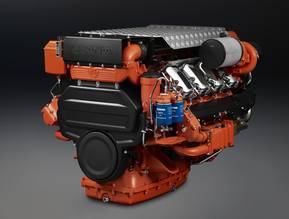US Harbor Craft: Measuring Opportunity for Zero Emissions
There are more than 4,000 harbor craft vessels in the U.S. deemed highly suited for zero-emissions operations, according to a recent report produced by CALSTART in partnership with Intelatus Global Partners.
The report - “Sizing the U.S. and California Harbor Craft Market” - looked at the U.S. commercial harbor craft and inland and nearshore vessels above 600 kilowatts (kW) or 805 brake horsepower. Approximately 10,000 vessels were counted in total, including crew and supply boats, ferries and excursion vessels, fishing vessels, pilot boats, towboats, tugboats, workboats and other vessel types.
Of those vessels, 4,405 were identified as most suitable for hydrogen or electric zero-emission operations, including ferries, pilot boats, towboats and tugboats. More than half of these (58%) are towboats, and some 56% are 25 years of age or older.
In Service CAT 1 Harbor Craft by Age Group
Age Group | Ferry | Pilot | Towboat | Tugboat | Total |
0-5 | 56 | 2 | 199 | 7 | 264 |
6-10 | 85 | 331 | 67 | 483 | |
11-15 | 46 | 1 | 317 | 113 | 477 |
16-20 | 78 | 205 | 138 | 421 | |
20-25 | 98 | 2 | 118 | 80 | 298 |
≥25 | 500 | 1 | 1,385 | 576 | 2,462 |
Total | 863 | 6 | 2,555 | 981 | 4,405 |
Source: Intelatus Global Partners
“The 2,462 older vessels represent the lower hanging fruit in terms of suitability for replacement or repowering with zero-emission solutions, whether hydrogen, fully electric or other zero-emission technology,” said Philip Lewis, director of research at Intelatus Global Partners.
Vessel owners seeking to slash emissions from their operations can choose from a bouquet of energy carrier and converter options, though a great number of factors must be considered—often on a case-by-case basis to meet the given needs of a specific vessel and its operational profile.
“In the short-sea and inland segment, the most suitable zero-emission options include renewable based hydrogen, hydrogen-based fuels and renewable electricity stored in battery energy storage systems,” Lewis said. “All the options have advantages and disadvantages, chief among which is the cost and availability of zero-emission fuel, the certification that a fuel is truly zero-emission and the availability of infrastructure and equipment to produce, distribute and convert zero-emission fuels. As the energy transition continues to gather pace, these challenges will, in theory, be addressed.”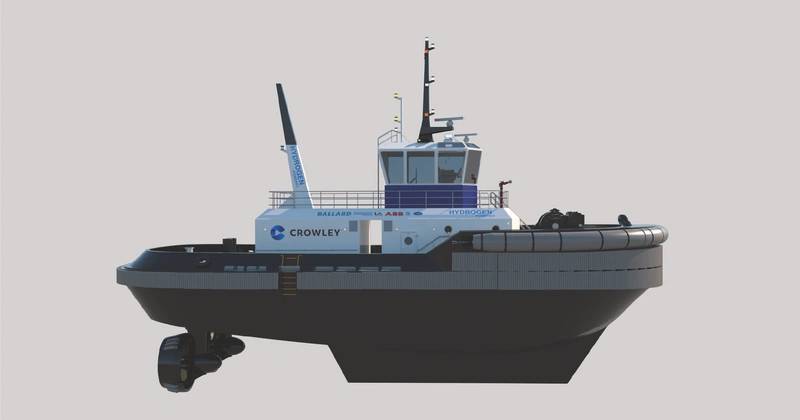 CALSTART is leading the HyZET project to develop a tugboat that runs fully on hydrogen fuel (Image: Crowley)
CALSTART is leading the HyZET project to develop a tugboat that runs fully on hydrogen fuel (Image: Crowley)
Increasingly, global, regional, national and local agencies are promoting various measures aimed at reducing harmful emissions from the maritime sector. As a result of this regulatory environment, as well as growing commercial pressures to prioritize environmental, social and governance (ESG) objectives, the adoption of zero-emission vessels is accelerating, though technical and financial challenges remain.
“In the U.S., the focus of standards is tilted toward the reduction of NOx and particulate matter PM,” Lewis noted. “California is in a unique position that it can set its own emission standards, which are currently higher than those mandated by the federal Environmental Protection Agency (EPA). Where feasible, California encourages the use of zero-emission options.”
The CALSTART-Intelatus study, funded in part by the Clean Off-Road Equipment Incentive Project (CORE), profiled the U.S. harbor craft fleet, but also dialed in specifically on California, finding 676 registered vessels in the state that meet the report’s criteria. Of the 360 (53%) vessels determined to be in service, slightly more than two thirds are classed highly suitable for a transition to zero emissions operations.
In Service Cat 1 California Harbor Craft
Age Group | Ferry | Pilot | Towboat | Tugboat | Total |
0-5 | 3 | 2 | 5 | 1 | 11 |
6-10 | 10 | 3 | 5 | 18 | |
11-15 | 5 | 1 | 9 | 4 | 19 |
16-20 | 7 | 5 | 11 | 23 | |
20-25 | 13 | 2 | 3 | 9 | 27 |
≥25 | 66 | 45 | 35 | 146 | |
Total | 104 | 5 | 70 | 65 | 244 |
Source: Intelatus Global Partners
CALSTART is currently leading a team of industry experts, including Crowley, ABB, DNV, Chart Industries, Ballard Fuel Cell Systems and the Port of Los Angeles, in a project called HyZET, which aims to develop a fully hydrogen-powered tugboat.
Lewis said that in California tugboats are considered the closest segment technically for the adoption of the HyZET technology, compared to, say, the towboat segment, which in California includes a number of oceangoing ATBs that may prove less ready for the HyZET concept compared to, for example, towboats operating on the Mississippi River.
“The ferry and excursion vessels and pilot boats, especially those operating on the routine ferry routes, are generally well suited for zero-emission technologies, such as hydrogen and electricity,” Lewis added. “That said, some of the excursion vessels that venture further offshore may be less suited for short- and medium-term transition to hydrogen or fully electric technology.”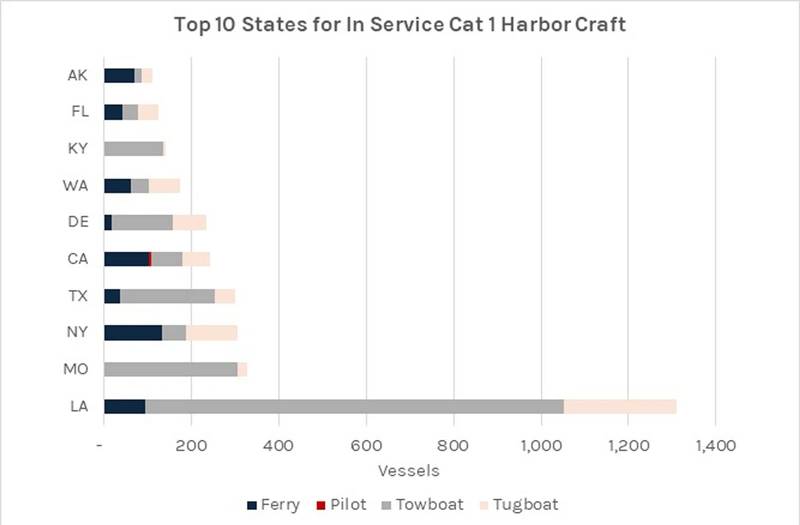 The vast majority (73%) of the U.S. harbor craft fleet is located within 10 states: Alaska, California, Delaware, Florida, Louisiana, Massachusetts, Missouri, New York, Texas and Washington. (Source: intelatus Global Partners)
The vast majority (73%) of the U.S. harbor craft fleet is located within 10 states: Alaska, California, Delaware, Florida, Louisiana, Massachusetts, Missouri, New York, Texas and Washington. (Source: intelatus Global Partners)



